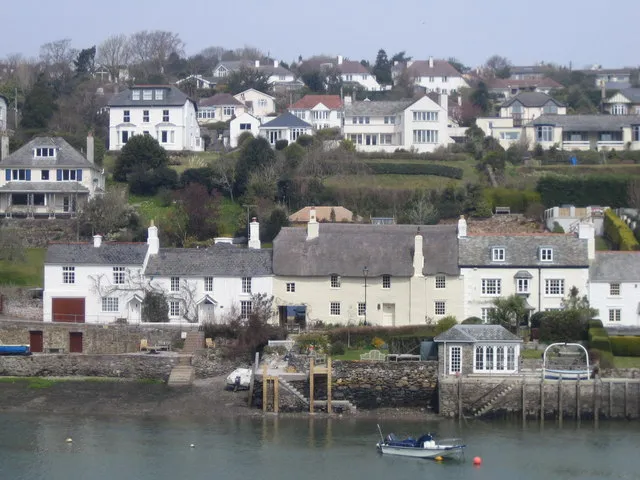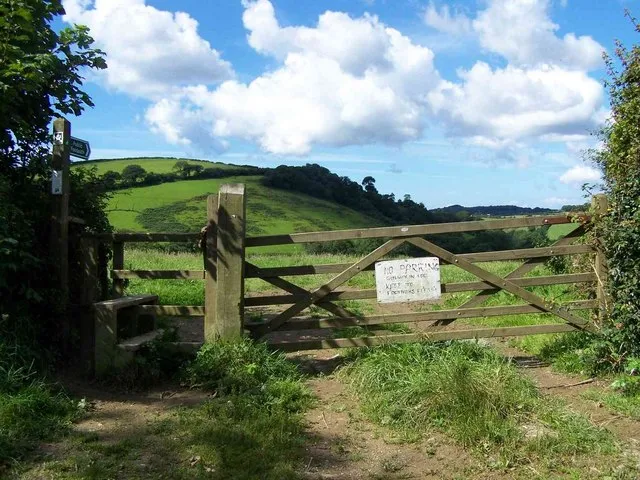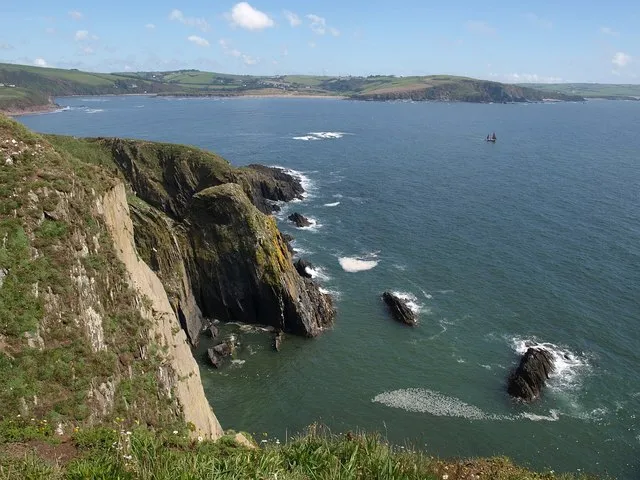Exploring the South Hams district of Devon is a delicious adventure. It’s impossible to resist the lure of lush country lanes that lead to a secret world of maze-like fishing villages and hidden sandy beaches. And what about a tidal island with a dreamy art deco palace, or picture-book cottages under cosy thatched roofs, or the glamorous holiday home of Dame Agatha Christie?
Here, scattered hamlets nestle in the folds of undulating landscapes shaped by fascinating geology. There are 60 miles of magnificent coastline, five estuaries and six market towns in the South Hams – so much to explore. My journey to four distinctly different secret corners of Devon begins on the sheltered wooded estuary of the tranquil River Yealm.

© Copyright Chris Andrews and licensed for reuse under this Creative Commons Licence
The handsome villages of Newton Ferrers (above) and Noss Mayo appear like a pair of mischievous fraternal twins, separated and planted on opposite sides of Newton Creek. Governed by the tidal River Yealm, a narrow concrete causeway – the Voss – connects the communities at low tide. On each side of the creek, winding lanes squeeze between tightly packed whitewashed cottages, many with private quays. Boats are everywhere, wedged in hilltop gardens, leaning against walls and jostling on pontoons – this is the perfect spot for messing about on the river, and there are plenty of opportunities for rowing and sailing.
Newton Ferrers, the larger of the twins, takes its name from the 11th-century Ferrers family of landowners, to whom the village was gifted following the Norman Conquest. Noss Mayo translates as Mathew’s Nose, named in honour of 13th-century local landowner Mathew Fitzjohn. The two villages developed from cellars on the shore where farmers and agricultural labourers stored fishing boats and gear used to supplement their income. As the fishing industry flourished, so did the community. Houses replaced the cellars,while the fountain where the catch was gutted and cleaned is still standing outside Noss Mayo village hall.
The fishermen are now long gone, and only a handful of boatmen make their living on the water, the majority of the river’s craft are sailed simply for pleasure. Many of the cottages are second homes, although a small permanent community still thrives here. In summer, the population swells and the single-track road with passing places becomes congested. In light of this, it makes sense to explore the simple pleasures of these two villages on foot or afloat. While yachts are popular, and the rivalry is strong during the annual Yealm Regatta in July and August, the river also welcomes kayaks, sailing dinghies and rowing boats – even stand-up paddle boarders, whom I’ve watched floating along the tranquil estuary by moonlight.
Most visitors, however, either amble across the tidal creek at low ride or hop aboard the water taxi that operates between Yealm Steps, Warren Point and Wide Slip in summer. In Newton Ferrers, buy the booklet of local walks from Mr Tubbs’ pharmacy and work up an appetite for scones with clotted cream at the civilised Tearoom on the Green. Fresh crab sandwiches come with estuary views at The Dolphin Inn and Yealm Yacht Club Bistro welcomes visiting skippers and crews.
Cross the Voss walkway at low tide in the company of curlews and egrets, to explore Noss Mayo. From seats outside The Swan Inn, survey the excitement of feeding ducks and crabbing at Pope’s Quay below. Enjoy superb views from St Peter’s church, commissioned in the 19th century by the Baring family of merchant bankers. Watch Yealm Gig Rowing Club in action from the wharf of The Ship Inn, or swim and picnic at Cellar beach then investigate rock pools at Stoke beach.

© Copyright Geoff Pick and licensed for reuse under this Creative Commons Licence
Further inland, the small market town of Modbury is situated in a sheltered dip between Dartmoor and the sea. Pick up details of local walks (above) and a copy of the town trail from the information centre; within a short wander you’ll discover historic buildings associated with the wool industry between 1600-1800 and sites where Parliamentarians and Royalists clashed during the English Civil War. Brimming with ferns and wildflowers, lovely Runaway Lane was the escape route used by Royalists after the 1643 Battle of Modbury. This green highway linked the town with Orcheton Quay, giving access to the river Erme.
In 2007, Modbury became the first town in Europe to ban plastic bags, thanks to the efforts of Rebecca Hosking who was moved to action by the effect of discarded plastic bags on wildlife around the world. Local stores now sell Modbury’s own cotton carriers or offer bags to borrow and return.
And there’s plenty to fill them with in the town. The Little Bookshop is stuffed with second-hand reads to raise funds for St Luke’s Hospice and there’s a risk of getting lost in Pickles hardware shop, an Aladdin’s cave of essentials. I spent a good hour surrounded by contemporary art indoors and out at The Brownston Gallery and garden, and I lusted after glittering antique crystal at Erme Chandeliers. At The Modbury Inn, regulars work together to complete newspaper crosswords and the publican’s favourite walks are marked on a map on the wall.
This South Hams town also has curious transatlantic connections. Hatter John Batterson Stetson, inventor of the classic cowboy headgear, was descended from local stock and Modbury-born Richard King made a fortune in New York and funded, in 1840, the Modbury Institution on Brownston Street, a library with lecture facilities and splendid Doric columns opposite the old tannery.

© Copyright Derek Harper and licensed for reuse under this Creative Commons Licence
Back at the coast, Burgh Island is just a five-minute stroll across the sandy, lifeguarded beach at Bigbury-on-Sea. At high tide, Burgh Island Hotel’s unique sea tractor transports passengers through the waves.
This small rugged island has a fascinating history. In the 14th century, resident monks brewed mead and fishermen drank at the Pilchard Inn, still a fine place for tall tales and ghost stories. In the 18th century, the island became a bolthole for smugglers evading excise men. Appearances changed dramatically in 1929 when industrialist Archie Nettlefold commissioned an extraordinary hotel that looks rather like a white liner marooned on the cliff. Refined by architect Paul Roseveare in 1932, it soon became a seaside playground for the rich and famous – among them Noel Coward, Amy Johnson, Josephine Baker, Edward and Mrs Simpson.
Burgh still offers refuge and, when night falls and the tide wraps itself around the island, there’s magic in the air. This art deco palace welcomes non-resident guests to lunch on Sundays, when the dress code is smart-casual, and to black tie dinners on any evening (reservations are essential for both). If you can afford to stay longer, rooms are named after glittering guests. How about a balcony with westerly sea views and a vast bathroom, named in honour of Dame Agatha Christie? Inspired by the island setting, the whodunit queen wrote two novels here.
The Avon estuary at nearby Bigbury Bay is an example of the area’s fascinating geology; a river valley ‘drowned’ by rising sea levels at the end of the last ice age. Take the seasonal summer passenger ferry from Cockleridge Ham at Bigbury-on-Sea to Bantham Ham, where mighty dunes back a long stretch of fine sand. Good surf makes this the busiest and most popular beach in the South Hams.
High above the action on the waves, walking the South West Coast Path here is a delight; in summer the dunes and sea cliffs are alive with tiny white sea campion and gently bobbing thrift, stonechats and wheatear pepper the dunes while butterflies, moths and glowworms form a ever-changing foreground as you take in huge views across the bay to Burgh island.
Agatha’s Christie’s bolt-hole
Perched secretly in lush woodland above the river Dart, close by the South Hams hamlet of Galmpton, Greenway was Agatha Christie’s summer home between 1938-76. In this mansion house the colour of rich Devon cream, the writer relaxed with friends and family. Retreating from her famous persona, she was known locally by her married name, Mrs Mallowan. It’s easy to imagine her enjoying a Devon cream tea on the lawn or wandering through the magnificent woodland garden, taking zigzag paths to her private beach and Raleigh’s Boathouse, with its saltwater plunge pool on the Dart.
Indeed, Sir Walter Raleigh may have known the spot well; he was half brother to Sir John Gilbert who owned Greenway Court in the 16th century. Archaeologists have uncovered traces of the Tudor mansion on the site of the present house.
In 2000, the Christie family gave Greenway to the National Trust, and it was opened to the public in 2009. At the end of your journey through the South Hams, nothing beats a quiet sunny seat in the garden at Greenway beside the Dart. It’s the perfect spot to savour a classic Agatha Christie murder mystery. I recommend Dead Man’s Folly, in which super sleuth Hercule Poirot is invited to a grand house in Devon and makes a shocking discovery in the boathouse on the river…